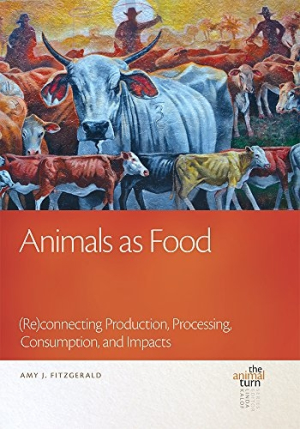Animals as Food
(Re)connecting Production, Processing, Consumption, and Impacts
An informed perspective and an objective voice contribute authority to this critique of animal farming and consumption.
In identifying the primary reasons why she wrote Animals as Food, Amy Fitzgerald points out several factors that dramatize the modern-day importance of the topic. She acknowledges, for example, the “growing cultural curiosity and unease” surrounding the use of animals as food, as well as a “growing critical consciousness about where our food comes from.” Just as compelling is the fact that the powerful US food industry providing animal-derived food products “has not been forthcoming about the questions consumers want answered.” This well-researched study traces the history of the human consumption of animals and also considers the contemporary impacts of processing and consuming animals.
Fitzgerald offers a carefully documented overview of the history and development of livestock production and processing in text that is both edifying and eye-opening. Her description of “the industrialization of slaughter and processing” is not for the squeamish, but it is necessary background for such a scholarly work. Of particular interest are the impacts, or “fallout,” of industrializing the animals-as-food process. Fitzgerald includes an intelligent discussion of animal welfare, worker safety and well-being, health impacts among the general public and consumers, environmental impacts, food insecurity, community impacts, and cultural impacts. The author nicely balances rational issues, such as food-borne illnesses and pollution, with emotional issues, such as the humane treatment of animals and the moral and health-related aspects of eating animals.
The final chapter of Animals as Food is “prescriptive” rather than “descriptive,” as the author puts it. Here, Fitzgerald suggests that “the status quo is not working,” and she “explores an array of alternatives” to the current system of industrial animal agriculture. The author wisely maintains a largely objective voice by deferring to other sources in presenting these alternatives; in fact, she does an admirable job of discussing both the pros and cons. In closing, Fitzgerald admits that while the picture she paints is somewhat bleak, she believes that “technological changes, environmental limits, political alliances, changing public sentiment, and legal challenges” may conspire to make positive changes in the industry.
Reviewed by
Barry Silverstein
Disclosure: This article is not an endorsement, but a review. The publisher of this book provided free copies of the book to have their book reviewed by a professional reviewer. No fee was paid by the publisher for this review. Foreword Reviews only recommends books that we love. Foreword Magazine, Inc. is disclosing this in accordance with the Federal Trade Commission’s 16 CFR, Part 255.

